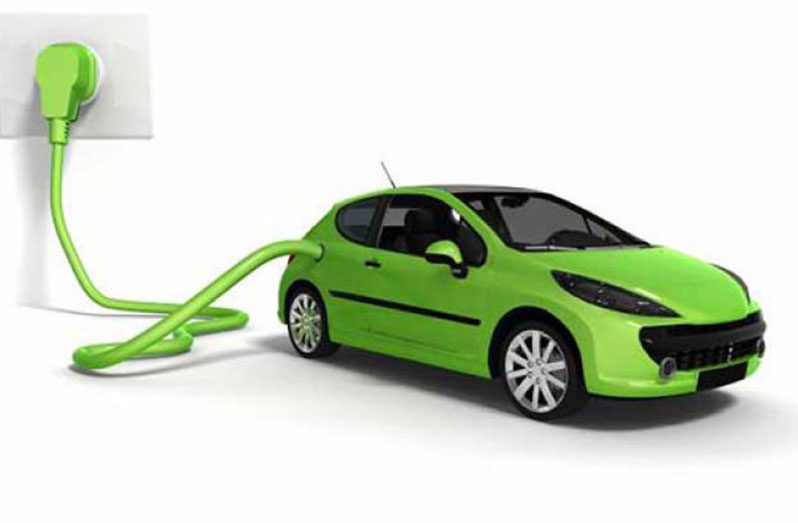–LCDS emphasises need for electric vehicle industry
AS Guyana positions itself for a sustainable future, Guyanese will have to be properly trained how to function in a low-carbon economy. This is outlined in the government’s expanded Low-Carbon Development Strategy (LCDS), which points to the importance of education, and the need for academic institutions to build resilience, and be able to respond to the many risks associated with climate change.
“Research has shown that education helps students develop a strong personal connection to climate solutions, as well as a sense of personal agency and empowerment; it can have consequential impact on students’ daily behaviours, and decision making that reduces their overall lifetime carbon footprint,” the LCDS 2030 notes.
At the policy level, the document had outlined that initiatives will be implemented to develop capacities for trade in low-carbon services; align institutions and programmes to low-carbon development, including the University of Guyana and Technical and Vocational Institutions; and develop qualification and experience capabilities to function in a low-carbon economy.
Specific reference has been made in relation to the implementation of low-carbon technologies within the transport sector, which would ultimately complement related programmes for cleaner power generation, and nature-based solutions. “The LCDS will seek to reduce the demand for imported fossil fuels for vehicular transport, and its resultant impact on the local environment and health sector,” the document has indicated.
It has noted, too, that among the low-carbon strategies within the transport sector, the LCDS will support the increasing of efficiency levels of vehicle consumption of fuel, and will foster the development of an electric vehicle industry to substitute fossil fuels.
“Specifically, in investing in low-carbon transportation infrastructure, the LCDS will lower the cost of doing business; maintain Guyana’s territorial integrity; create ease-of-access to social and economic services; improve user experience; and support economic development,” the Strategy indicates.
The development of an electric vehicle industry, according to the Strategy, would be supported by the government’s implementation of a comprehensive energy mix, which focuses on using solar, wind, hydro and natural gas as renewable sources of electricity.
As it relates to solar power, Guyana has already secured US$75 million in funding to establish solar farms in eight grids, with the intention of producing some 27.8 megawatts-peak (MWp) of solar power to the Demerara-Berbice Interconnected System (DBIS).
The farms are expected to be up and running by 2023, paving the way for solar-generated power to replace 30 per cent of the electricity being supplied to areas along the Essequibo Coast, Linden, Bartica, Lethem, Mabaruma, Mahdia, Leguan and Wakenaam.
As for ‘hydropower’, the Dr. Irfaan Ali-led government is looking to establish at least two massive-scale hydropower projects, namely the almost $US1 billion Amaila Falls Hydropower Plant, and another which is expected to be finalised by 2025.
Further, as Guyana continues to balance its oil wealth with its global climate change commitments, the government is also pursuing the establishment of a US$900 million gas-to-shore project, which will see natural gases offshore Guyana being transported to an onshore plant, using state-of-the-art pipelines. After this process, the gas will then be treated and converted to power, after which it will be received by a power plant to supply the national grid.
Also a critical component of Guyana’s transition to a low-carbon economy is the improvement of the country’s digital infrastructure. To this end, the LCDS makes specific reference to the expansion of e-Governance programmes, as well as access to improved connectivity across all regions of Guyana.
“The ICT Access and e-Services for Hinterland, Poor, and Remote Communities Project is still ongoing, and aims to provide the necessary infrastructure, equipment, hardware, and software necessary to enable access to high-quality ICT, training and e-services in all parts of Guyana, with particular attention given to vulnerable groups and remote communities who might otherwise be excluded,” the strategy highlights.
Additionally, the aforementioned transition also includes fashioning a climate-resilient health sector, especially given the fact that climate change has been shown to increase illness and death from floods, heatwaves and droughts; water and food insecurity; increased transmission and spread of infectious diseases, diminished air quality; and adverse physical and mental health impacts on populations.
To this end, the LCDS 2030 will focus on ensuring the sector is served by sufficient numbers of highly-trained medical personnel, who are knowledgeable in providing services to a low-carbon economy; modernising and upgrading facilities and equipment to facilitate accurate diagnosis, treatment, and care; efficient management systems, data and information storage and retrieval, including cloud or offsite back up storage of records in the event of site destruction or damage due to fires, floods or other means; and effective, quality medication appropriately stored, delivered and administered in a timely manner.
It is in keeping with these health sector objectives that the Ministry of Health has embarked on converting five local hospitals into SMART facilities, designed to function in a low-carbon environment; among other things, the upgraded hospitals would be able to conserve and utilise renewable energy and save water.
Moreover, for Guyanese to be able to function in a low-carbon economy, efforts will also have to be made to adapt to climate-resilient agriculture technologies and systems, which protect crops from the harmful effects of climate change.
Under its agricultural commitments, the LCDS seeks to strengthen sea and river defence systems; improve flood control and water management (drainage/kokers); address drought prevention (including in Hinterland regions); implement climate smart initiatives; strengthen institutions such as the National Drainage and Irrigation Authority and Hydrometerological Department, etcetera; and improve response capability for climate event.
Although it outlines a myriad of policies intended to transform Guyana into a low-carbon nation, the LCDS is not set in stone. As a matter of fact, the document is only in its draft phase, currently opened for the public’s feedback, which is likely to wrap up in February 2022. Based on stakeholders’ input, the revised version of the strategy will be produced by the end of April 2022.












